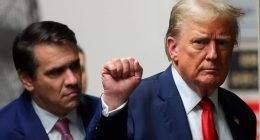Stay informed with free updates
Simply sign up to the Artificial intelligence myFT Digest — delivered directly to your inbox.
The writer is a policy researcher at Rand and author of ‘Deterrence under Uncertainty: Artificial Intelligence and Nuclear Warfare’
This spring, the US and China are expected to start talks on artificial intelligence safety. Expectations are low. These might be no more than conversations between specialists and analysts, rather than senior government officials.
But early, unproductive talks aren’t a total loss — as illustrated by nuclear arms negotiations during the cold war. Failed attempts to negotiate with Moscow in the 1950s paved the way for vital breakthroughs with the Soviets a decade later.
Analogous US negotiations with Beijing on AI today could lay the foundation for the moment when both countries’ leaders realise how much they stand to gain from shared commitments.
Artificial intelligence and other emerging technologies are already central to military competition. China has used AI for cyber operations against the US and our allies, as well as for modernising its military systems. And although there are peaceful uses for AI, much like nuclear technology, the risks of misuse could be severe.
US-Soviet nuclear negotiations in the 1950s appeared to serve as little more than venues for mutual recrimination and the airing of grievances. But the 1958 Test Ban Technical Conference led to optimism that there was a technical way to verify that a nuclear weapon had been tested by either country. Further progress came at the Surprise Attack Conference that same year.
It took until 1963, after years of dialogue, for the US and the Soviet Union to reach two breakthrough agreements. The Partial Nuclear Test Ban Treaty prohibited nuclear weapons tests in the atmosphere, the ocean, or outer space. While both superpowers continued underground testing, the partial test ban constrained competition and slowed the arms race.
That year diplomats also concluded an agreement to establish a “hotline” to give heads of government with nuclear weapons access to a reliable and secure communications channel during crises. While the hotline technology has advanced, the US and Russia still maintain this connection today.
It was, of course, the October 1962 Cuban missile crisis that convinced the US and Soviet leaders that they urgently needed to reduce the probability of nuclear war. But the 1963 agreements came together quickly because of the foundation established by the “failed” negotiations of the 1950s. Their diplomats had already engaged deeply on these subjects. The gateway was then open to more ambitious arms control and confidence-building agreements, such as the 1972 Strategic Arms Limitation Talks (Salt).
Today both the US and China’s military strategists fear falling behind their rivals in harnessing AI and other emerging technologies. This is the kind of dynamic that stokes costly arms races, increases the probability of international crises and make crises that do occur more likely to escalate to large-scale war.
De-escalation channels akin to the Washington-Moscow hotline are needed before a crisis hits. During the Cuban missile crisis, Soviet premier Nikita Khrushchev resorted to transmitting negotiation terms via Radio Moscow for want of a prompt, reliable means of communicating with president John F Kennedy in private. (US officials have long emphasised the value of analogous “hotlines” with counterparts in China. So far Beijing has mostly refused to use the few established channels in times of crisis, so there is room for progress on this front as well.)
In an atmosphere of deepening mutual suspicion, trying to engage with China on military uses of AI may seem pointless. But compared with US-Soviet tensions in the 1950s and early 1960s — an era marked by several crises that nearly exploded into nuclear war — present US-China relations actually aren’t so bad. If negotiations go somewhere, US security might be palpably improved. It they fail, there is little downside.
Patience is needed. Indeed, the US government cut funding for non-governmental dialogues with China on nuclear issues because in 15 years, they hadn’t spurred official Track 1 negotiations. That was in 2019, just as China began its nuclear build-up, leaving the US without a channel for dialogue just as it needed one.
If China agrees to talk at any level about AI, American officials should treat the engagement as exploratory, with the expectation that near-term progress will probably be modest. But as history shows, such preliminary discussions are an essential precursor to meaningful diplomatic breakthroughs later.
Also Read More: World News | Entertainment News | Celebrity News






![Miranda Lambert's Weight Loss Journey [Before and After Photos]](https://bbcgossip.com/wp-content/uploads/2024/05/Miranda-Lamberts-Weight-Loss-Journey-Before-and-After-Photos-260x140.jpg)

